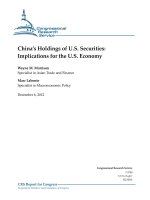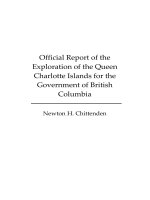Enhancement of seedling vigour through bio-priming for barnyard millet var. MDU 1
Bạn đang xem bản rút gọn của tài liệu. Xem và tải ngay bản đầy đủ của tài liệu tại đây (352.57 KB, 6 trang )
Int.J.Curr.Microbiol.App.Sci (2019) 8(4): 2254-2259
International Journal of Current Microbiology and Applied Sciences
ISSN: 2319-7706 Volume 8 Number 04 (2019)
Journal homepage:
Original Research Article
/>
Enhancement of Seedling Vigour through Bio-priming
for Barnyard Millet Var. MDU 1
S. Iswariya1, K. Sujatha2* and R. Subhashini3
Department of Seed Science and Technology, Agricultural College and Research Institute,
Madurai -625 104, Tamil Nadu, India
*Corresponding author
ABSTRACT
Keywords
Biopriming,
Barnyard millet,
Physiological
quality and Biochemical
parameters
Article Info
Accepted:
17 March 2019
Available Online:
10 April 2019
The experiment was conducted to determine the enhancement of seedling vigour
through bio priming for barnyard millet. Seeds of barnyard millet var. MDU 1
were bioprimed with water, Azophos, Pseudomonas fluroscens, PPFM and the
combinations of Azophos+ Pseudomonas fluroscens at 20% concentration for 8 h.
Bio- primed seeds were evaluated for its germination, seedling length, vigour
index, dehydrogenase, α-amylase and microbial count. Results revealed that seeds
bioprimed with Azophos+ Pseudomonas fluroscens @ 20% for 8h performed
positive influence on physiological quality and biochemical parameters. In
addition microbial population of 107x104 CFU g-1 of seed was observed in
Azophos+ Pseudomonas fluroscens primed seeds compared to other priming
treatments. These treatments can be utilized for enhancing seedling vigour in
barnyard millet.
Introduction
Small millets are nothing but group of small
millet grasses. The group comprising of finger
millet, kodo millet, little millet, foxtail millet,
barnyard millet and proso millet are
considered as “Nutricereals” and are a source
of food, feed and fodder. They are known for
resilience and drought enduring capacity and
are well suited for contingency crop planning,
addressing the issues of climate change.
Millets in general provide many essential
vitamins and micronutrients that can bolster
nutrition for those living in dryland areas.
They are especially rich in iron, calcium and
zinc, and have other dietary qualities that can
help stave off anemia, celiac disease, and
diabetes.
Now-a-days unpredictable and inconsistent
rainfall, poor quality seeds and changing
environment conditions affect the crop
establishment and leading to crop failure.
Among the different means of solutions, seed
priming is one of the simple and low cost
technology especially for dry land farmers.
Seed priming is a controlled hydration
process that involves exposing seeds to low
water potential that restrict germination, but
permits pre-germinative physiological and
2254
Int.J.Curr.Microbiol.App.Sci (2019) 8(4): 2254-2259
biochemical changes to occur (Rink et al.,
2017). Different priming methods are
followed by researchers. One of the best and
ecofriendly priming method is biopriming.
The seed biopiming is an effective seed
treatment to increase the rate, uniformity of
emergence and crop establishment in most of
the crops especially in advanced countries it
integrates the biological and physiological
aspects of enhancing growth, disease control
and increase in yield. Excessive and
continuous use of chemical fertilizers coupled
with pesticides and fungicides have damaged
the soil fertility which causes deleterious
effects on crop cultivation and productivity.
Now-a-days, chemical fertilizers are replaced
by environment friendly biofertilizers.
Biofertilizers improve the root development,
vegetative growth and nitrogen fixation. They
liberate growth promoting substances and
vitamins and help to maintain soil fertility,
improve physical properties of soil, soil health
in general and help in the bio-control of
disease. The reports on positive and
significant response of biopriming alone or
combinations on physiological quality in
barnyard millet is very meager therefore the
present study was carried out to identify the
effect of bio priming in barnyard millet.
The strains were cultured in specific culture
media for each. Liquid based bio-inoculant
formulations were prepared for priming the
seeds. Broth at different concentrations viz., 5,
10, 20% was prepared. The seeds were soaked
in respective solution with duration of 6, 8
and 12 hours with 1:1 ratio (v/w). After the
priming treatments the seeds were shade dried
to original moisture content of 12% and
germination test was conducted (ISTA, 1999)
with four replicates of 100 seeds in paper
towels. The test conditions were 25±2ºC
temperature, 95±5% Relative Humidity and
illumination with fluorescent light (750-1250
lux). Final count of normal seedling was
recorded on 7th day.
Materials and Methods
Results and Discussion
Genetically pure and fresh barnyard millet var
MDU 1 seeds were collected from
Department of Seed Science and Technology,
Agricultural College and Research Institute,
Madurai. Bioinoculants viz., Azospirillum (SP
7), Phosphate Solubilizing bacteria (Pb-1),
Potash release bacteria (KRB 7), Pinkpigmented
facultative
methylotrophic
bacteria (PPFMs)
and
Pseudomonas
fluroscens, Silicate Solubilizing bacteria
(SSB-7) were obtained from Department of
Agricultural
Microbiology,
Agricultural
College and Research Institute, Madurai,
Tamil Nadu.
Based the pilot studies the best treatments
were selected and taken for research.
Significant differences were observed among
the treatments in which the seeds bio primed
with 20% Azophos + Pseudomonas
fluroscens for 8h have recorded 100%
germination, root length (15.2 cm), shoot
length (8.8 cm) and vigour index (2400).
Observations on germination, seedling length
and vigour index were recorded. Biochemical
parameters
viz.,dehydrogenase
activity
(Kittock and Law 1968) were expressed as
OD value @ 480 nm and α-amylase activity
expressed as mg maltose min -1 (Paul et al.,
1970) respectively. Microbial population in
the bioprimed seeds was assessed. All
analyses were made in duplicate. The data
were statistically analysed using AGRES
software. Percentage data were transformed to
arcsine values wherever necessary.
The hydroprimed seeds recorded 88%, 11.8
cm, 8.1 cm and 1751 for germination, root
length, shoot length and vigour index
respectively (Fig. 1–6).
2255
Int.J.Curr.Microbiol.App.Sci (2019) 8(4): 2254-2259
Fig.1 Effect of biopriming on germination percentage and vigour index in barnyard millet
Fig.2 Effect of biopriming on root length and shoot length in barnyard millet
Fig.3 Effect of biopriming on microbial population in barnyard millet
2256
Int.J.Curr.Microbiol.App.Sci (2019) 8(4): 2254-2259
Fig.4 Effect of biopriming on dehydrogenase and α-amylase activity in barnyard millet
Fig.5 Seedling growth of barnyard millet – 20% at 8 h
Hydroprimed
Azophos+Psudomonas fluroscens
Fig.6 Microbial population of Azophos+Pseudomonas fluroscens
Psudomonas fluroscens
Phosphate solubilizing bacteria
(PSB)
Azosprilium
2257
Int.J.Curr.Microbiol.App.Sci (2019) 8(4): 2254-2259
Bio priming using biological agents has
PGPR activity that increase germination and
improve
seedling
establishment
and
proliferation of PGPR on the spermosphere
(Taylar and Harman, 1990).
Seed
biopriming
with
Azophos
+
Pseudomonas
fluroscens
might
have
stimulated the hypocotyl and epicotyl growth
and cell elongation by inducing secretion of
GA3 resulting in increased root length and
shoot length. Similar findings reported by
Sakthivel et al., 2009 in tomato;
Sivasankaridevi et al., 2013 in cucumber;
Sivakalai and Krishnaveni, 2017 in pumpkin;
Sridevi and Manonmani, 2016 in kodo millet
and barnyard millet and Madhukeshwara et
al., 2017 in maize.
Among the bioinoculants Azophos +
Pseudomonas fluroscens showed higher
microbial population compared to other biopriming agent (107x104 CFU). Hydroprimed
seeds recorded nil microbial population.
Percentage
increase
over
control
(hydropriming) was by 12, 22.36, 7.95, 27.04,
45.24, 83.52 and 100 for germination, root
length, shoot length, vigour index,
dehydrogenase activity, α-amylase activity
and microbial count respectively. The seed
moisture availability might have maintained
the viability of microorganisms in the seed.
Similar findings were reported by (Anitha,
2010, Meena et al., 2012, Raja et al., 2017,
Subhaswaraj et al., 2017, Nithya et al., 2017
and sivakalai and krishnaveni, 2017.
The enzyme activities of dehydrogenase and
α-amylase were recorded higher in Azophos +
Pseudomonas fluroscens primed seeds. The
enhancement in the seedling growth enzyme
activity and microbial count noticed in this
study can be attributed to suppression of
deleterious
microorganisms,
pathogens,
production of plant growth regulators such as
Gibberellic acid (GA), Cytokinin, Indole
acetic acid(IAA) increased availability of
minerals and other ions and also more water
uptake (Ramamoorthy et al., 2000). The
positive effect of Azophos + Pseudomonas
fluroscens bio primed seeds might be due to
plant growth promoting substances or phyto
hormones and also enhancing the nutrient
mobilization from the seed.
It could be concluded that barnyard millet
seeds soaked in equal volume of liquid
microbial culture Azophos+Pseudomonas
fluroscens @ 20% for 8h registered higher
seedling vigour.
References
Anitha, K. G. 2010. Enhancing seded
germination of mono and dicotyledons
through IAA production of PPFM.
Trends Soils Sci. Plant Nutr. J., 1: 1418.
ISTA, (1999). International Rules for Seed
Testing. Seed Sci. & Technol.,
Supplement Rules, 13, 209-355.
Kittock, D., and A. Law, (1968). Relationship
of Seedling Vigor to Respiration and
Tetrazolium Chloride Reduction by
Germinating Wheat Seeds 1. Agronomy
Journal, 60(3), 286-288.
Madhukeshwara BP and Ashok S Sajjan.
2017. Influence of bio-priming on field
performance and yield in maize hybrid.
ACTA scientific agriculture 1(1): 16-19.
Meena, K.K., M. Kumar, M.G. Kalyuzhnaya,
M.S Yandigeri, D.P. Singh, A.K.
Saxena and D.K. Arora. 2012.
Epiphytic
pink-pigmented
methylotrophic
bacteria
enhance
germination and seedling growth of
wheat (Triticum aestivum) by producing
phytohormone.
Antonie
Van
Leeuwenhoek, 101: 777-786.
Nithya N., R. Geetha, K. Sivasubramaniam,
N.O. Gopal, C. Vanniarajan. 2017.
Effect of biopriming on germination
2258
Int.J.Curr.Microbiol.App.Sci (2019) 8(4): 2254-2259
characterristics of PMK (R) 4 under
salinity conditions. Int. J. Curr.
Microbiol. App. Sci. 6(12): 895-904.
Paul, A.K., S. Mukh and S.M. Sircar. 1970.
Metabolic changes in rice seeds during
storage. Ind. J. Agric. Sci., 40(12):
1031-1036.
Raja K., K. Sivasubramaniam
and
R.Anandham. 2017. Manipulation of
seed germination and vigour by bio
priming with liquid microbial cultures
in paddy (Oryza sativa L.). International
journal current microbiology and
applied science. 6(10): 1612-1618.
Ramamoorthy K., N. Natarajan, A.
Lakshmanan.
2000.
Seed
biofortification with Azospirillum spp.
For improvement of seedling vigour and
productivity in rice (Oryza sativa
L.).Seed sci. & technol., 28:809-815.
Rinku V Patel, Krishna Y Pandya, R. T. Jasrai
and Nayana Brahmbhatt. 2017. Effect
of hydropriming and biopriming on
seed germination of brinjal and tomato
seed. Research journal of agriculture
and forestry sciences 5(6):1-14.
Sakthivel
U.,
S.
Mahalakshmi,
B.
Karthikeyan. 2009. Studies on isolation
and characterisation and its effect of
seed
inoculation
of
PGPR
(Pseudomonas fluroscence) on yield of
tomato. Journal of phytology 1(1): 3339.
Sivakalai R., K. Krishnaveni. 2017. Effect of
bio-priming on seed yield and quality in
pumpkin cv CO2. International journal
of current microbiology and applied
science 6(12):85-90.
Sivasankaridevi T., M.K. Shivaprakash and
C.C. Maina. 2013. Efficacy of seed biopriming enhancing vigour of cucumber
(Cucumissativus L.) under biotic stress
conditions.
Mysore
journal
of
agricultural science 47(1): 107-111.
Sridevi R., V. Manonmani. 2016. Seed
priming effect on physiological traits of
kodo millet and barnyard millet.
International journal of agricultural
science and research 6(4): 187-194.
Subhaswaraj, P., R. Jobina, P. Parasuraman
and B. Siddhardha. 2017. Plant growth
promoting activity of Pink Pigmented
Facultative
MethylotrophMethylobacterium extorquens MM2 on
Lycopersicon esculentum L. J. App.
Biol. Biotech., 5(1):42-46.
Taylor, A. G., and Harman, G. E., 1990,
Concept and technologies of selected
seed
treatments.
Annu.
Rev.
Phytopathol. 28: 321-339.
How to cite this article:
Iswariya, S., K. Sujatha and Subhashini, R. 2019. Enhancement of Seedling Vigour through
Bio-priming for Barnyard Millet Var. MDU 1. Int.J.Curr.Microbiol.App.Sci. 8(04): 2254-2259.
doi: />
2259









